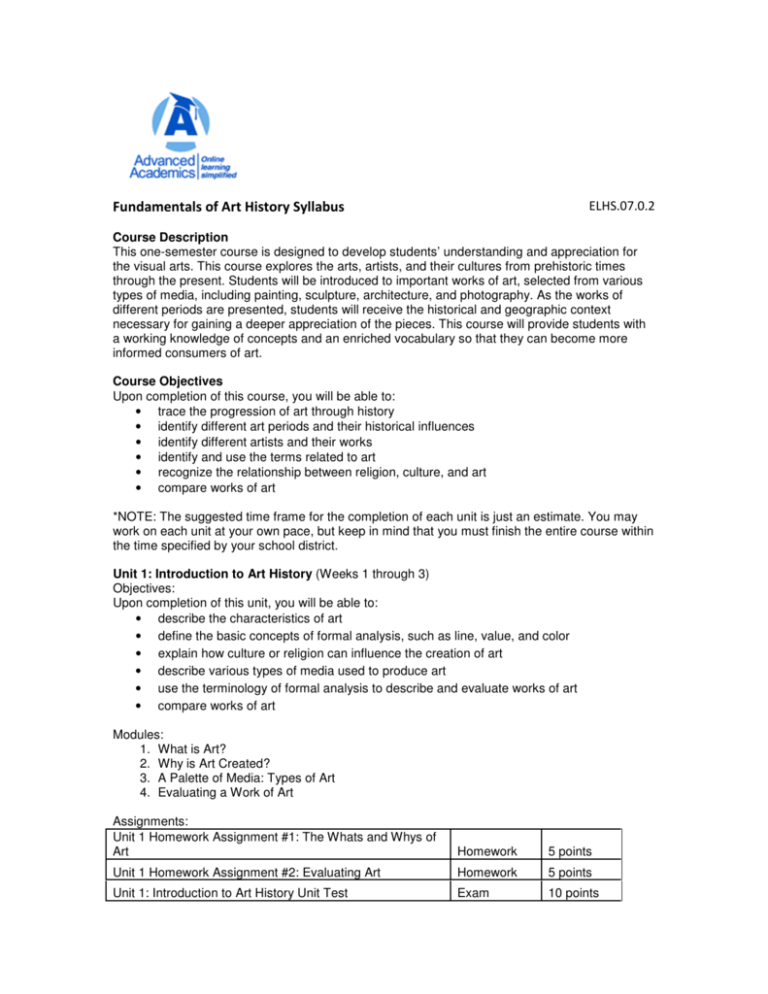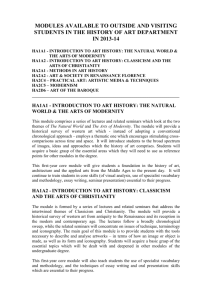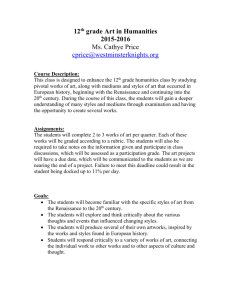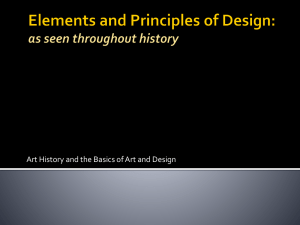
Fundamentals of Art History Syllabus
ELHS.07.0.2
Course Description
This one-semester course is designed to develop students’ understanding and appreciation for
the visual arts. This course explores the arts, artists, and their cultures from prehistoric times
through the present. Students will be introduced to important works of art, selected from various
types of media, including painting, sculpture, architecture, and photography. As the works of
different periods are presented, students will receive the historical and geographic context
necessary for gaining a deeper appreciation of the pieces. This course will provide students with
a working knowledge of concepts and an enriched vocabulary so that they can become more
informed consumers of art.
Course Objectives
Upon completion of this course, you will be able to:
• trace the progression of art through history
• identify different art periods and their historical influences
• identify different artists and their works
• identify and use the terms related to art
• recognize the relationship between religion, culture, and art
• compare works of art
*NOTE: The suggested time frame for the completion of each unit is just an estimate. You may
work on each unit at your own pace, but keep in mind that you must finish the entire course within
the time specified by your school district.
Unit 1: Introduction to Art History (Weeks 1 through 3)
Objectives:
Upon completion of this unit, you will be able to:
• describe the characteristics of art
• define the basic concepts of formal analysis, such as line, value, and color
• explain how culture or religion can influence the creation of art
• describe various types of media used to produce art
• use the terminology of formal analysis to describe and evaluate works of art
• compare works of art
Modules:
1. What is Art?
2. Why is Art Created?
3. A Palette of Media: Types of Art
4. Evaluating a Work of Art
Assignments:
Unit 1 Homework Assignment #1: The Whats and Whys of
Art
Homework
5 points
Unit 1 Homework Assignment #2: Evaluating Art
Homework
5 points
Unit 1: Introduction to Art History Unit Test
Exam
10 points
Unit 2: The Ancient World (Weeks 4 through 6)
Objectives:
Upon completion of this unit, you will be able to:
• discuss the styles and characteristics of several ancient civilizations
• compare artworks from within civilizations and between civilizations
• analyze specific artworks from each civilization and discuss their inspirations, styles, and
purposes
• explain how ancient civilizations made use of different media types and how the handling
of these media types differed
• describe how civilizations built on the styles of the cultures coming before them to
develop their own unique styles
Modules:
1. Art in Prehistoric Europe and North America
2. Ancient Near Eastern Art
3. Egyptian Art
4. Aegean Art
5. Greek Art
6. Roman Art
Assignments:
Unit 2 Homework Assignment #1: Prehistoric, Ancient, and
Egyptian Art
Unit 2 Homework Assignment #2: Aegean, Greek, and
Roman Art
Homework
5 points
Homework
5 points
Unit 2: The Ancient World Unit Test
Exam
10 points
Unit 3: The Middle Ages (Weeks 7 through 8)
Objectives:
Upon completion of this unit, you will be able to:
• understand how and why the artistic styles changed during this time period
• learn about the growth of the Christian religion and the enormous impact it had on the
production of art
• learn about the changes in architecture occurring during this period, understanding why
and how they were made
• identify components of the basic cathedral plan of this time period
Modules:
1. Early Christian and Byzantine Art
2. Early Medieval Art
3. Romanesque Art
4. Gothic Art
Assignments:
Unit 3 Homework Assignment #1: Early Christian,
Byzantine, and Medieval Art
Unit 3 Homework Assignment #2: Romanesque and Gothic
Art
Homework
5 points
Homework
5 points
Unit 3: The Middle Ages Unit Test
Exam
10 points
Unit 4: The Renaissance (Weeks 9 through 10)
Objectives:
Upon completion of this unit, you will be able to:
• understand how the styles of the Renaissance changed to depict figures and their
environments more realistically
• realize what impact research and advancement in the sciences had on the works
produced by Renaissance artists
• describe how the development of oil paint led to the ability of artists to use more vibrant
colors and greater details
• understand how artists of the High Renaissance were viewed as geniuses rather than
simply as artists
Modules:
1. The Early Renaissance
2. The High Renaissance in Italy
3. The Renaissance in the North
Assignments:
Unit 4 Homework Assignment #1: The Italian Renaissance
Homework
5 points
Unit 4 Homework Assignment #2: Renaissance in the North
Homework
5 points
Unit 4: The Renaissance Unit Test
Exam
10 points
Art History Midterm Exam (Week 11)
Objectives:
Upon completion of this unit, you will be able to:
• review information acquired and mastered from this course up to this point
• take and pass a course exam based on material from the first four units in this course
(Note: You will be able to open this exam only one time.)
Assignment:
Fundamentals of Art History Midterm Exam
Exam
18 points
Unit 5: The Baroque (Weeks 12 through 13)
Objectives:
Upon completion of this unit, you will be able to:
• understand the changing styles in the art of the Baroque period
• describe how the religious turmoil of the period greatly affected the types of art produced
• understand how the differing culture and economy of the Netherlands allowed for greater
production of secular art and subjects representing everyday life
• realize that the rift between the classes in addition to the Spanish Inquisition led to the
production of a great deal of violent art in this area
Modules:
1. The Baroque in Italy and Spain
2. The Baroque in Flanders and the Netherlands
3. The French Baroque and Rococo Styles
Assignments:
Unit 5 Homework Assignment #1: Baroque in Italy, Spain,
Flanders, and the Netherlands
Unit 5 Homework Assignment #2: French Baroque and
Rococo
Homework
5 points
Homework
5 points
Unit 5: The Baroque Unit Test
Exam
10 points
Unit 6: The Modern World (Weeks 14 through 15)
Objectives:
Upon completion of this unit, you will be able to:
• describe the period of turmoil during which the Neoclassicism period occurred
• explain how Napoleon’s desire to associate himself with the ancient Roman emperors
affected Classical ideas and styles
• identify the most important artist associated with the Neoclassical style
• describe the artwork of Jacques Louis David
• identify the most important sculptor of the Neoclassical school
• describe what types of things the Romanticism movement focused on
• describe how the Romanticism movement started
• describe the types of subjects realists depict
• describe the goals of Realist artists
• describe who the Pre-Raphaelite Brotherhood was
• explain what the goals of the Impressionist painters were and explain how they attained
their goals
• explain how the Impressionist movement got its name
• identify the name of the literature movement that occurred in parallel with a movement in
music
• describe how the Impressionist movement began
• describe how the Post-Impressionist movement developed
Modules:
1. Neoclassicism
2. Romanticism
3. Realism and the Pre-Raphaelite Brotherhood
4. Impressionism and Post-Impressionism
Assignments:
Unit 6 Homework Assignment #1: Neoclassicism and
Romanticism
Unit 6 Homework Assignment #2: Realism, Impressionism,
and Post-Impressionism
Homework
5 points
Homework
5 points
Unit 6: The Modern World Unit Test
Exam
10 points
Unit 7: Art in the Twentieth Century (Weeks 16 through 17)
Objectives:
Upon completion of this unit, you will be able to:
• identify stylistic movements seen in the 20th century as well as artists associated with
these movements
• understand how the styles of the 20th century evolved from each other as well as from
earlier styles
• comprehend how artists moved away from producing art to appeal to their audience and
toward art for their own personal expression as well as how the artists returned to an
interest in audience approval in the Pop Art movement
• understand not only painting and sculptural styles of the 20th century but also gain an
understanding of 20th century architecture and photography
Modules:
1. Twentieth Century Painting
2. Twentieth Century Sculpture
3. Twentieth Century Architecture
4. Twentieth Century Photography
Assignments:
Unit 7 Homework Assignment #1: Twentieth Century
Paintings and Sculpture
Unit 7 Homework Assignment #2: Twentieth Century
Architecture and Photography
Homework
5 points
Homework
5 points
Unit 7: Art in the Later Twentieth Century Exam
Exam
10 points
Art history Final Exam (Week 18)
Objectives:
Upon completion of this unit, you will be able to:
• review information acquired and mastered from this course
• take and pass a course exam based on material from all units in this course (Note: You
will be able to open this exam only one time.)
Assignment:
Fundamentals of Art History Final Exam
Exam
25 points
* NOTE: If you have a disability or condition that may affect your ability to succeed in this course,
please contact your teacher. It’s important that you discuss the problem with him or her so
accommodations may be made to give you every opportunity to perform well. Your teacher and
virtual school program coordinators are committed to helping students with disabilities succeed,
and every request will be treated with respect and confidentiality.
©2007 Advanced Academics, Inc. All Rights Reserved.






